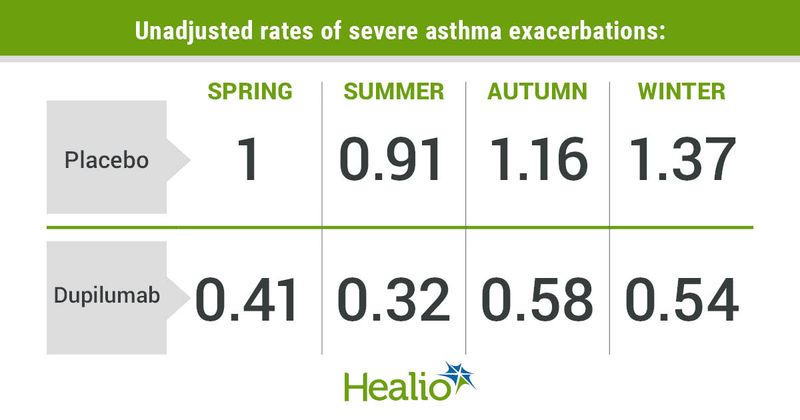Asthma exacerbation reductions similar across seasons with dupilumab
Click Here to Manage Email Alerts
Key takeaways:
- Asthma exacerbation rates ranged from 0.91 to 1.37 for the placebo group and from 0.32 to 0.58 for the dupilumab group.
- Exacerbations peaked in winter with placebo and in autumn with dupilumab.
Patients with type 2 inflammation experienced reductions in asthma exacerbations with dupilumab, with no differences between seasons, according to a study published in Annals of Allergy, Asthma & Immunology.
Patients experienced these reductions regardless of whether they had or did not have evidence of allergic asthma as well, Anju T. Peters, MD, professor, departments of medicine and otolaryngology head and neck surgery, Northwestern University Feinberg School of Medicine, and colleagues wrote.

The post-hoc analysis examined data from the LIBERTY ASTHMA QUEST study, where patients aged 12 years and older with uncontrolled, moderate to severe asthma received dupilumab (Dupixent; Regeneron, Sanofi) or a placebo.
It also included data from the LIBERTY ASTHMA TRAVERSE study, which included patients with asthma who had previously participated in a dupilumab study including QUEST. These patients all received dupilumab.
Overall, the population included 424 patients on placebo (mean age, 48 years; 61.8% female; 86.6% white) and 803 on dupilumab (mean age, 47.4 years; 59.7% female; 83.6% white). Also, 74.2% of these patients lived in the Northern Hemisphere.
During the year before the studies, mean severe exacerbation rates included 2.09 (standard deviation [SD], 1.94) for the patients on dupilumab and 2.25 (SD, 1.95) for the patients on placebo.
Among patients with type 2 asthma in QUEST, unadjusted rates of severe asthma exacerbations included 1 (spring), 0.91 (summer), 1.16 (autumn) and 1.37 (winter) for the placebo group and 0.41 (spring), 0.32 (summer), 0.58 (autumn) and 0.54 (winter) for the dupilumab group.
The placebo group also had significantly higher (P < .001) proportions of patients who experienced one or more severe exacerbations across all four seasons compared with the dupilumab group, including 20.8% vs. 10% (spring), 18.2% vs. 7.3% (summer), 22.2% vs. 12.6% (autumn) and 26.4% vs. 12% (winter).
Also among patients with type 2 asthma, unadjusted rates of severe asthma exacerbations in TRAVERSE ranged from 0.25 (summer) to 0.45 (winter) for those who had used both placebo and dupilumab and from 0.25 (summer) to 0.38 (winter) for those who had only used dupilumab.
TRAVERSE additionally found proportions of patients with type 2 asthma who experienced one or more severe asthma exacerbations ranging from 5.1% (summer) to 8.9% (winter) for those who had used both placebo and dupilumab and from 5.2% (summer) to 8.1% (winter) for those only on dupilumab.
Specifically, patients with type 2 asthma who also had evidence of an allergic asthma phenotype had unadjusted rates of severe asthma exacerbations that varied from 0.84 (summer) to 1.29 (winter) in the placebo group and from 0.31 (summer) to 0.61 (autumn) in the dupilumab group during QUEST.
Proportions of patients in this group with one or more severe asthma exacerbations were significantly higher (P < .01) among those on placebo across all seasons, ranging from 17.3% (summer) to 24.2% (winter), compared with those on dupilumab, which ranged from 7.1% (summer) to 13% (autumn).
Unadjusted rates of severe asthma exacerbations among patients with type 2 asthma but who did not have any evidence of an allergic asthma phenotype in QUEST ranged from 1.01 (summer) to 1.48 (winter) for the placebo group and from 0.33 (summer) to 0.54 (autumn) for the dupilumab group.
Similarly, proportions of patients in the same group who experienced one or more severe asthma exacerbations were significantly higher (P < .01) for those on placebo, ranging from 19.3% (summer) to 29.5% (winter), compared with those on dupilumab, which spanned 7.6% (summer) to 12% (autumn).
During TRAVERSE, the patients with type 2 asthma who used placebo before dupilumab and those who only used dupilumab had similar unadjusted severe exacerbation rates and similar proportions of patients with one or more severe asthma exacerbations, including patients who did and did not have evidence of an allergic phenotype.
Further, the researchers said, the low exacerbation rates achieved with dupilumab during QUEST continued through years 1 and 2 of TRAVERSE across the overall type 2 population and in the groups that did and did not have an allergic asthma phenotype.
Based on these findings, the researchers said, dupilumab significantly reduced severe asthma exacerbations among patients with type 2 asthma during QUEST with no differences between seasons.
